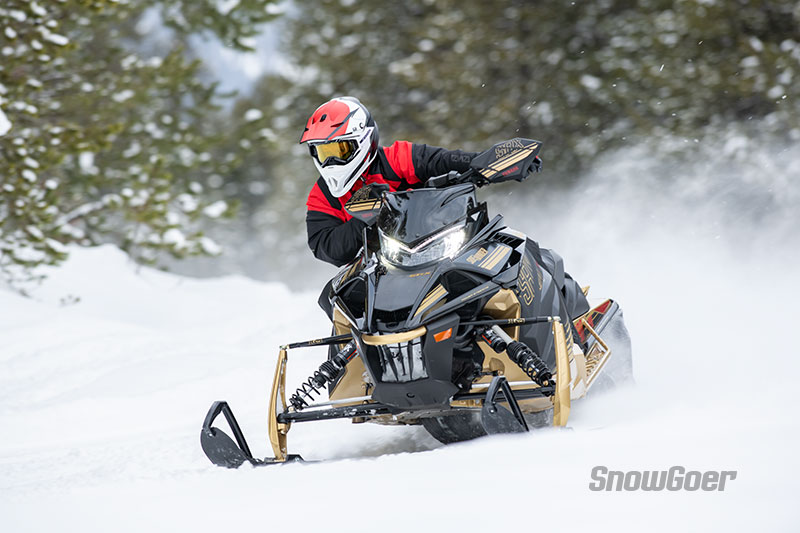While most of the attention in Yamaha’s 2008 lineup has gone toward the FX Nytro lineup, another machine has undergone a more quiet metamorphosis: the 2008 Yamaha RS Vector GT.
With its shift to the Deltabox II chassis, the machine has become more refined and better mannered for serious trail riding. It will be a welcome update for Yamaha riders and others interested in an all-day cruiser.
The first (and most immediately noticeable) feature on this machine are the ergos.
At first sit, the driver will notice that it’s definitely got the rider-up-and-forward feel. It’s not the dramatic high positioning of the Phazer or Nytro models, but it’s a good intermediary step for riders coming off of a low-slung machine. No more knees-in-the-face driving, which was the feel of previous Vectors.
The official spec of the new positioning includes handlebars that are 6 inches closer to the machine’s front and 4 inches taller than last year. The seat is 2.5 inches taller, but scoots the driver 6 inches forward. This was especially noticeable when driving: more than one tester noted that they felt forced more forward than expected. Overall, though, the seat was rated as “comfortable” and “cushy.”
For the cruiser that this is, we expected a few more creature comforts. The standard electric start and reverse are nice, as is the DC outlet plug and the grips that heat all the way to the end of the hook. Two things are missing, though: mirrors and decent storage space. People who do serious touring or group riding want a quick look in the mirror to make sure the rest of the group is there — not a dangerous, neck cranking twist. And for the storage, the new back-seat trunk helps, but it’s still small by today’s standards. Blame the rear exhaust that usurps the traditional trunk. One reach into the cavern on an Arctic Cat will prove the Yamaha storage inadequate.
The handlebars are just the right height and angle for the sled. The standard hooks are welcome, and make for easier full-lean turns. The windshield is certainly more substantial than on other Yamaha models, but it directed wind straight into the chest.
“Looks” need to fall under first impressions, as well. The machine looks sharp with the Yamaha 40th Anniversary/replica 1976 SRX trim. The retro styling works on this sled, giving a bold, historic look to an updated machine. The pearl white color shimmers in the sun. These graphics are a $200 option. The standard colors are Team Yamaha blue and white.
The mantra for this machine is “smooth,” starting with engine.
Yamaha four-strokes are the smoothest engines on the market, hands down. The RS Vector is no exception.
The RS Vector still uses the 973cc, 120 hp Genesis 120. It has a smooth ramp-up and even power delivery. The power is adequate for this machine, though we did wonder how it would feel with the extra pop from the new Genesis 130FI used in the new Nytro series.
As we rode it, though, the 120 seems the perfect match for this chassis in terms of power and control. The Apex, the original Deltabox II chassis machine, hosts the 150 hp Genesis 150FI. This engine can almost overpower the machine in the yank-your-arms-out-of-the-sockets type of way. Consider the RS Vector a kinder, gentler version of the Apex. It’s easier to control, and makes for better trail performance.
The chassis also lends to its good trail manners. The rider-forward seating puts the driver in a more active stance for when the word “attack” flashes though the driver’s mind. It’s also a more modern feel. But even though an aggressive ride is possible on this machine, it’s not the only ride. It’s comfortable for an all-day, high-mile ride — and bumps don’t crush through the suspension and up the drivers’ back as with the prior Vector.
While the rear suspension still isn’t perfect, the Deltabox II chassis is a much better home for the Mono Shock RA rear suspension. It also helps that the shock was recalibrated for this sled.
The one shock is a fade-resistant HPG model and offers 11.5 inches of travel. It still adjusts compression damping via a dial at the driver’s left leg. We had it in a middle setting and it absorbed small to medium bumps quite well.
Yamaha rates this suspension as good up to moderate bumps, and that’s fairly accurate. Anything more than medium chop, and the suspension just can’t keep up with itself. Riders who really like the whoops (or who typically find themselves on rough trails) will either hate this setup or start pricing out an aftermarket solution.
The front suspension uses dual-clicker HPG shocks with 9 inches of travel. We liked the range of adjustability on these, as well, with 12 clicks of compression and 20 clicks of rebound. It’s fun to play around with the settings to find optimal performance.
There’s no question that this is an improved machine. We didn’t know how much the Vector needed the Deltabox II chassis until we rode the 2008 model.
This machine’s forte is smooth, swoopy trails. If we were heading to Quebec, or even parts of Michigan’s U.P., this machine would be on our trailer.






